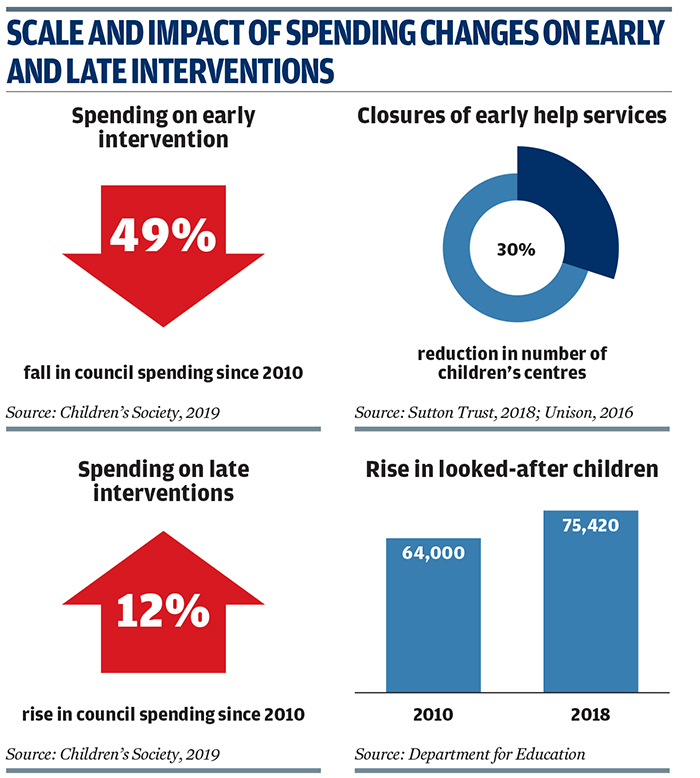Children and Young People's Services: Funding and Spending 2010/11 to 2017/18
Priya Patel, policy, research and public affairs assistant, The Children’s Society
Monday, August 26, 2019
An overview of the latest trends in funding and spending on children and young people's services.
Report by: The Children's Society (February 2019)
Ahead of the expected 2019 Spending Review, this report provides an overview of the latest trends in funding and spending on children and young people's services, illustrating the scale of the challenges facing local authorities. This report has found that between 2010/11 and 2017/18 funding available for local authority children and young people's services has fallen by 29 per cent, while local authority spending on such services has fallen by 16 per cent. There has also been a shift from spending on early intervention services such as children's centres to late intervention services such as children in care.
Funding for local authority children and young people's services has fallen by £3bn between 2010/11 and 2017/18 - a 29 per cent reduction. There has been a notable fall in central government funding per child and young person from £813 in 2010/11 to £553 in 2017/18.
At the same time, local authority spending on children and young people's services fell by £1.7bn - a 16 per cent reduction.
London remains the region with the largest fall in local authority spending since 2010/11. There is also a difference in spending between the North and South of England. Between 2010/11 and 2017/18, the North of England has seen a spending fall of 19 per cent. This compares with 15 per cent in the South and Midlands.
Between 2010/11 and 2017/18 the most deprived local authorities have reduced spending on children's services by almost five times as much as the least deprived areas. It is noticeable how difficult local authorities have found absorbing cuts to central government grants without cutting spending.

Early intervention services
Early intervention services which step in early to prevent problems escalating are a broad group that provide help at a different times depending on the needs of each child, young person or family -including both universal and targeted approaches. These can, for example, include parenting programmes in children's centres that provide help for parents who might be finding their child's behaviour difficult to manage, or youth groups that provide opportunities for young people who face a challenging home life.
Alongside early intervention services, there are a number of teams and professionals who are responsible for taking more immediate steps to help children where they reach a statutory threshold for receiving help. They reflect the need to step in because problems have escalated to crisis point. In addition to being more costly, the child and their family, by the time of reaching crisis point, have already experienced harm. This makes investing in early intervention services all the more valuable to local authorities and families alike.
Early intervention spending
In the last eight years, spending on early intervention services has fallen by 49 per cent. The fall in spending is driven by reductions in two main service areas - children's centres and services for young people. More than 1,000 children's centres have closed since 2009 and 603 youth centres have closed since 2012.
This inevitably leads to a reduction in the level of support available to children, young people and their families. In worst cases it means the chances to spot signs of emerging problems are missed.
Local authority spending on late intervention services
In the last eight years, spending on late intervention services has increased by 12 per cent. The increase in late intervention spending is driven by two main areas of spending - safeguarding and children in care. The increase in spending reflects rising demand, leading to late intervention representing a greater proportion of children's service budgets than ever before. The continued demand on these services makes it difficult for local authorities to reverse the shift towards late intervention without additional investment.
Implications for practice
The lack of available funding is forcing local authorities to increasingly focus on late intervention services combined with the statutory responsibility to deliver them. Without reducing or limiting demand for late intervention services for children and young people, pressure will only continue to increase. Additional funding for local authorities to prioritise early intervention is needed.
Central government should:
- Provide additional funding for children's services in the Spending Review to address the estimated £3bn funding gap facing local authorities by 2025.
- Ensure that there is a clear link between the likely level of need and the level of funding available in each local area.
- Ensure that all local authorities have the resources to sustain a consistent offer of early intervention.
The Children's Society is a national charity that works with the country's most vulnerable children and young people. Research summaries provided by Priya Patel




